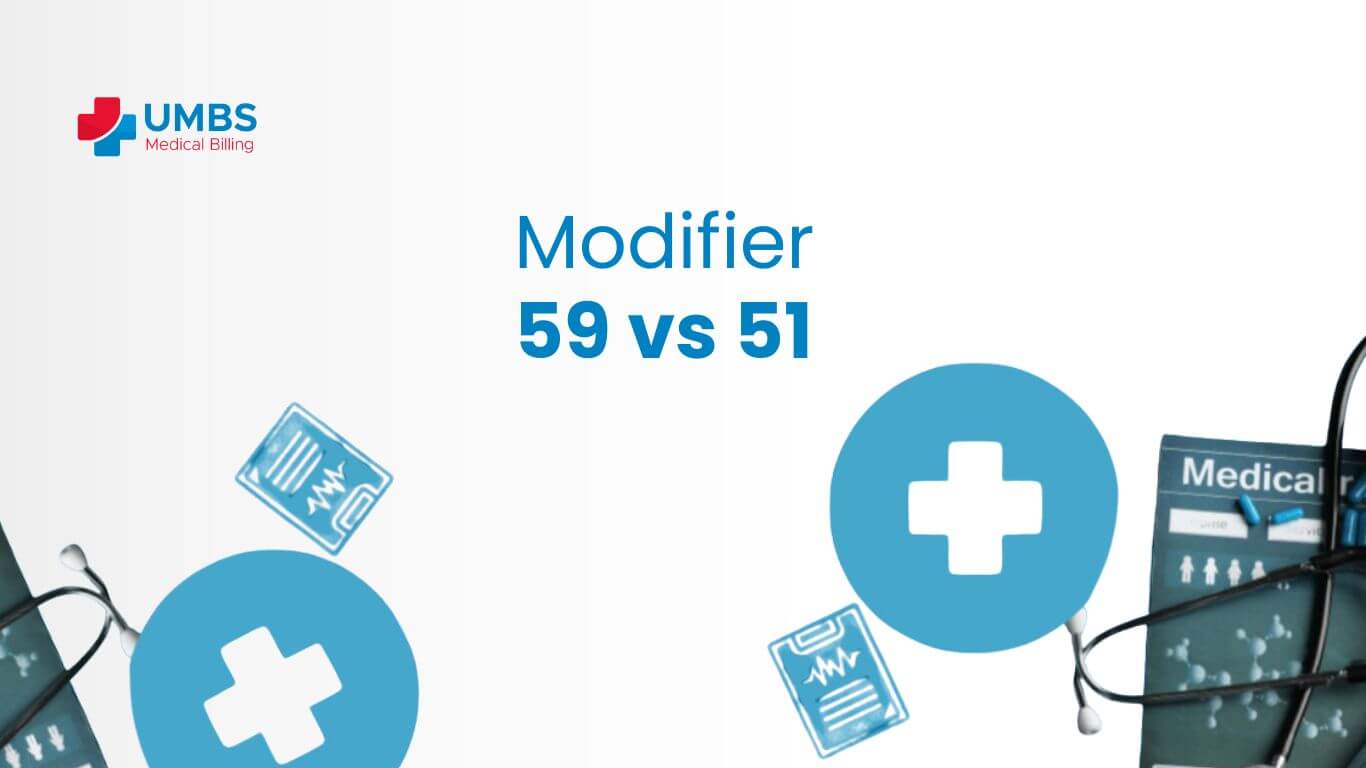A modifier is a code that might include additional services performed or any adjustments made during the treatment to clarify things to make the payments easier. Modifiers bring accuracy to payments and help healthcare providers to bill insurance companies in the right way and get reimbursements on time.
Modifier 51- Detailed Guide:
Modifier 51 is used when multiple procedures are performed. This is usually applied when your provider performs surgical services. There are different scenarios in which it is included in order to bill accurately and effectively. We’ll start by describing what modifier 51 does precisely, then go over how and when to use it, in order to put everything into perspective and give readers a better grasp of the modifier.
As mentioned earlier, Modifier 51 is generally utilized by doctors who bill for surgical procedures. According to CPT rules, the 51 modifiers should be used when “multiple procedures, other than E/M services, are performed at the same session by the same individual. Modifier 51 can be appended to the additional procedure or service code(s) to identify the additional process(s) or service(s).
Modifier 51 reports that a practitioner performed multiple surgical procedures during one treatment session. The modifier is applied to any secondary procedures performed. Here I want to explain the coding procedure of modifier 51. The coder needs to list the highest paying procedure first and other lowest paying will come under modifier 51. Below are some examples to explain it.
Real-life Clinical Scenarios to use Modifier 51:
Let’s look at some instances of modifier 51 being used correctly for various surgical operations so that you can better grasp when to utilize it.
Scenario 1:
A doctor does an excision of a cancerous skin lesion. Another skin lesion is found while doing the treatment and the doctor needs to treat it at the same time with the patient’s permission. After getting permission, the doctor takes a biopsy in the new location. In order to accurately and suitably bill, the coder would provide the following list of surgical services rendered:
- 12031 (wound closure)
- 11600-51 (excision of malignant lesion
- 11100-51 (biopsy of skin, single lesion)
This is an excellent example of how our coding rules and coding assumptions diverge. Because the excision was the reason the patient sought therapy, many billing and coding personnel would believe it should be included as the primary procedure. However, as modifier 51 is reliant on procedure cost, we discover that the closure—which has the highest cost—should be billed as primary, and that modifier 51 is required for the second and subsequent excision and biopsy procedures, which have lesser costs.
Scenario 2:
A patient is 10 weeks pregnant and facing vaginal bleeding. After examination, she is diagnosed with miscarriage and doctors recommend immediate treatment. The patient also requests the placement of an IUD. The gynecologist’s doctor performs a surgical completion of the miscarriage and inserts the requested IUD during this visit.
- Modifier 51 would be applicable in this scenario as follows:
- 58912 (incomplete abortion completed surgically)
- 58300-51 (insertion of IUD)
- 76817 (ultrasound)
Modifier 51 is not Necessarily Needed:
Billing employees should be proactive and knowledgeable about the payer standards and billing industry, just like they should be with everything related to provider service billing. Being aware of and flexible enough to adjust to any shifting need for modifiers will help the practice stay ahead of the curve in terms of billing.
Medicare’s internal systems are set up to automatically add modification 51 to the applicable procedure code or codes and deduct the required amount from the remaining services that are invoiced; thus, the agency no longer needs modifier 51. If you understand your region’s payer’s law and they follow Medicare’s guidelines, you can avoid claim denials.
Modifier 59 overview
Correct billing is mandatory for quick and accurate reimbursements. However, many billers do not understand modifiers and how to include them in billing. Modifiers are added to CPT codes to explain accurately the procedures performed or services taken.
A modifier should never be used to get higher reimbursement. Modifiers can be tricky, and sometimes providers can inappropriately use them, which leads to claim denials.
What is modifier 59?
Modifier 59 is used for Distinct procedural services. This is used when a distinct procedure is performed on the same day which is independent from the other services performed. This may represent a different treatment or surgery on different organs. If the use of any other modifier is appropriate, it would be preferred to use rather than modifier 59. If no other modifier is suitable and the use of modifier 59 best explains the circumstances, then it should be used.
When to use modifier 59?
The 59 modifier is one of the most misused modifiers. The most common reason it should be used is to indicate that two or more procedures were performed at the same visit but at different sites on the body.
When using the 59 modifier as a distinct and separate service, patients’ medical files should include documentation that the services were performed separately. The insurance company may request to review the record before reimbursing the full amount for the CPT code.
Modifier 59 examples
If a physical therapist performed manual therapy and therapeutic activity in the same visit, then modifier 59 will be used here.
Modifier 59 can only be added if two distinct procedures are performed separately at 15-minute intervals. If the therapist applies the procedures simultaneously, then modifier 59 will not be applicable.
Another example would be if the patient is treated on separate nerves, then it will come under separate treatment, and 59 modifiers will be applicable. If the treatment is performed on the same nerve, then the 59 modifier will not be used.
If the provider or coder has access to the patient’s chart then he/she should add 59 modifiers to a claim to prevent denial. On the other hand, if you are a biller and believe that the 59 modifier should be added but the provider didn’t mention it, you should confirm it from the provider. Don’t add the modifier without substantial evidence.
Example:
A dermatologist uses a BLU-U machine to perform Photodynamic Therapy on a patient’s face and scalp. The BLU-U was moved to treat the other extremities after the face/scalp session. Examples of coding: 9656796567–59. The face/scalp procedure that was done on the patient is the first code. The second procedure then has modifier 59 added to it, suggesting that a very different technique was carried out on opposite extremities. “When should one apply modifier 51 or 59?
The biopsy is the lesser-valued procedure performed during the same session, so modifier -51 would be placed. Additionally, modifier -59 would be connected to indicate that the biopsy was performed on a different lesion than the one that was excised, even though the biopsy is typically performed in conjunction with the excision of the same lesion.
Frequently Asked Questions
What is the most typical application of modifier 59?
Procedures and services other than E/M services that are appropriate in the given situation but are not typically reported simultaneously are identified with modifier 59.
Can 99213 be used with modifier 59?
Modifier 59 can be added to the testing code if the situation necessitates billing psychological testing (such as CPT code 96101) during a Level 3 established patient visit (CPT code 99213).
Which modifier will go first 26 or 51?
Add 26 before any other modification, always. Put 59 in the first place if you have two payment modifiers; 51 and 59 are a typical pair. If the numbers are 51 and 78, put 78 in the first place.
Can a claim have two uses of modifier 59?
Reminders for Billing
Charge for every service rendered in a single day under a single claim. Put a distinct line for each service you report. Attachment 59 to the ensuing steps (if relevant). Multiple lines with modifier 59 attached to the same method code demand that the claim’s supporting documentation be submitted.
Which modality to use 59 or 51 and when?
Modifier 51 is different from Modifier 59 in that it applies to operations that may be more frequently expected to be conducted within the same session, even though both apply to additional procedures performed on the same date of service as the principal procedure.
What is the purpose of the 59 modifier?
Modifier 59, for instance, ought to be applied when classifying a distinct session, distinct surgery or treatment, distinct site or organ system, distinct incision/excision, distinct lesion (noncontiguous lesions in distinct anatomic parts of the same organ), or distinct harm.
What is the purpose of modifier 51?
The definition of modifier 51 is “multiple surgeries/procedures.” Several procedures were carried out in the same surgical session on the same day. Diagnostic imaging services rendered by the same physician on the same day and during the same session are covered by the Multiple Procedure Payment Reduction.






